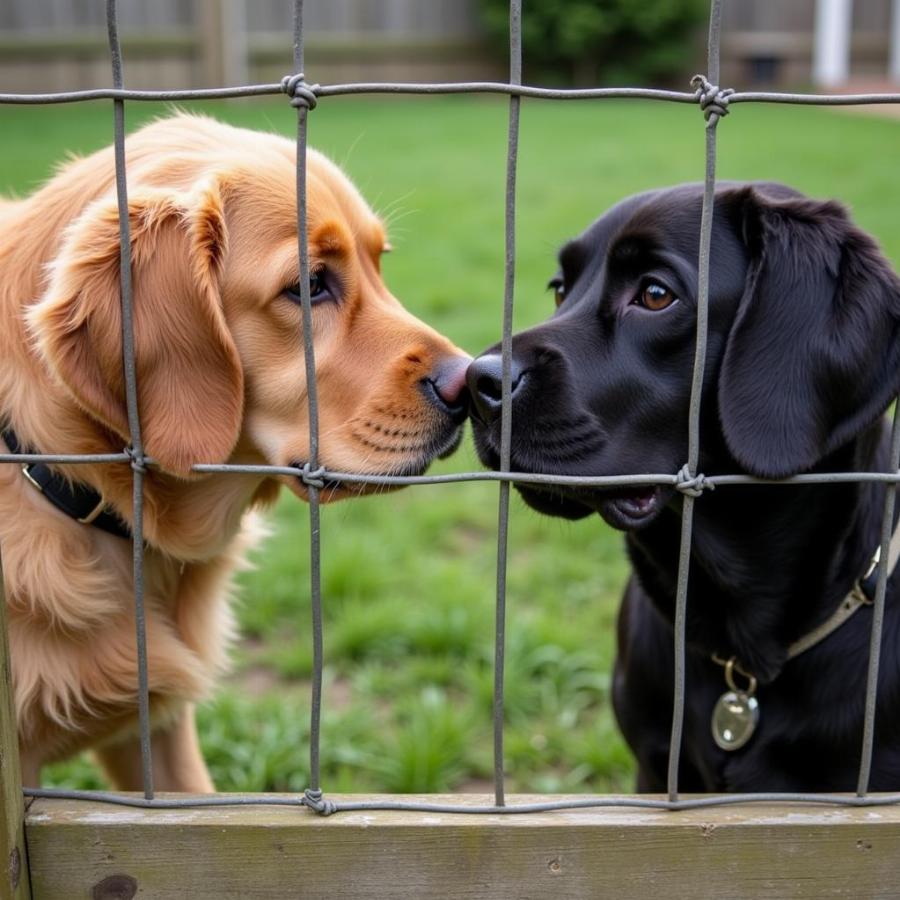The idea of “dogs in harmony” evokes images of peaceful cohabitation, with playful romps and shared naps. But achieving this idyllic state requires more than just hoping for the best. It demands understanding canine behavior, responsible pet ownership, and a commitment to creating a balanced and loving environment for your furry family members.
Decoding Canine Language: Understanding the Path to Harmony
Dogs may not speak our language, but they communicate in a myriad of ways. Recognizing and responding appropriately to these signals is paramount to establishing harmony in a multi-dog household.
- Body Language Basics: A wagging tail doesn’t always signify happiness, and a growl isn’t always aggression. Learn to read subtle cues like ear position, tail height, and overall posture to gauge your dog’s emotional state.
- Vocalizations: From playful barks to warning growls, dogs use a variety of vocalizations to express themselves. Familiarize yourself with these sounds and their meanings to anticipate and address potential conflicts.
Setting the Stage for Success: Pre-Introduction Strategies
Bringing a new dog into your home requires careful planning to ensure a smooth transition for everyone.
- Neutral Territory Introductions: First impressions matter! Orchestrate an initial meeting on neutral ground, allowing the dogs to interact without territorial anxieties.
- Gradual Integration: Avoid overwhelming your resident dog with the sudden presence of a newcomer. Implement gradual integration techniques, allowing the dogs to acclimate to each other’s scents and presence over time.
 Dogs meeting for the first time
Dogs meeting for the first time
Life with Multiple Dogs: Maintaining Harmony in the Home
Successfully integrating dogs into a harmonious pack involves establishing clear boundaries, routines, and providing individual attention.
- Resource Guarding: Prevention and Management: Food, toys, and even sleeping spots can become points of contention. Implement strategies to prevent resource guarding, and seek professional guidance if needed.
- Fairness is Key: Ensure all dogs receive equal attention, exercise, and training to prevent jealousy and rivalry.
- Creating Safe Spaces: Every dog needs a personal haven where they can decompress and enjoy solitude. Provide designated spaces like crates or beds for each dog.
Recognizing and Addressing Conflict: When Tensions Rise
Even in the most harmonious households, disagreements are bound to occur.
- Early Intervention: Address subtle signs of tension, like stiff body language or avoidance, before they escalate.
- Redirection and Separation: Diffuse potential conflicts by redirecting the dogs’ attention with toys or treats, or separating them briefly to allow emotions to settle.
- Seeking Professional Help: If conflicts persist or escalate, consult a certified dog trainer or behaviorist for guidance.
Conclusion: Nurturing Lasting Bonds
Achieving “dogs in harmony” is an ongoing process that requires patience, understanding, and a genuine love for your furry companions. By implementing these strategies and remaining attuned to your dogs’ needs, you can create a peaceful and loving environment where every member of your pack can thrive.
FAQs about Achieving Dogs in Harmony
Q: Can dogs of different breeds live together harmoniously?
A: Absolutely! While some breed combinations might require extra attention due to differing energy levels or play styles, successful multi-dog households rely more on individual temperaments and proper introductions than breed alone.
Q: My dogs used to get along, but now they’re fighting. What should I do?
A: Changes in routine, health issues, or even subtle shifts in pack dynamics can cause friction between dogs who previously coexisted peacefully. It’s essential to consult with your veterinarian and a certified dog trainer or behaviorist to identify the root cause and develop a behavior modification plan.
Q: How can I prevent fights over toys or food?
A: Establishing clear resource boundaries is crucial. Feed your dogs in separate locations, provide each dog with their own toys, and consider using positive reinforcement techniques to teach “leave it” and “drop it” commands.
Q: Is it normal for dogs to have occasional disagreements?
A: Just like humans, dogs won’t always see eye-to-eye. Occasional disagreements are normal, but it’s essential to differentiate between minor spats and serious aggression. If you’re unsure, err on the side of caution and consult a professional.
Q: What’s the most important thing to remember when striving for a harmonious multi-dog household?
A: Patience, consistency, and a deep understanding of canine behavior are key. By prioritizing your dogs’ well-being and committing to ongoing learning, you can foster a loving and peaceful environment for all.
Looking for More Information on Dog Care and Training?
Check out these helpful resources on our website:
- My Dog Hates My New Puppy
- Storage for Dogs
- Indoor Dog Kennels for Large Dogs
- Hearthwood Dog and Cat
- The Forever Dog Life
Beaut Dogs: Your Partner in Canine Care
Beaut Dogs is your go-to resource for all things dog-related. We’re committed to providing you with reliable, insightful information to help you navigate the joys and challenges of dog ownership. For personalized guidance and support, don’t hesitate to reach out to us at [email protected]. We’re here to help you and your canine companion achieve lasting harmony.